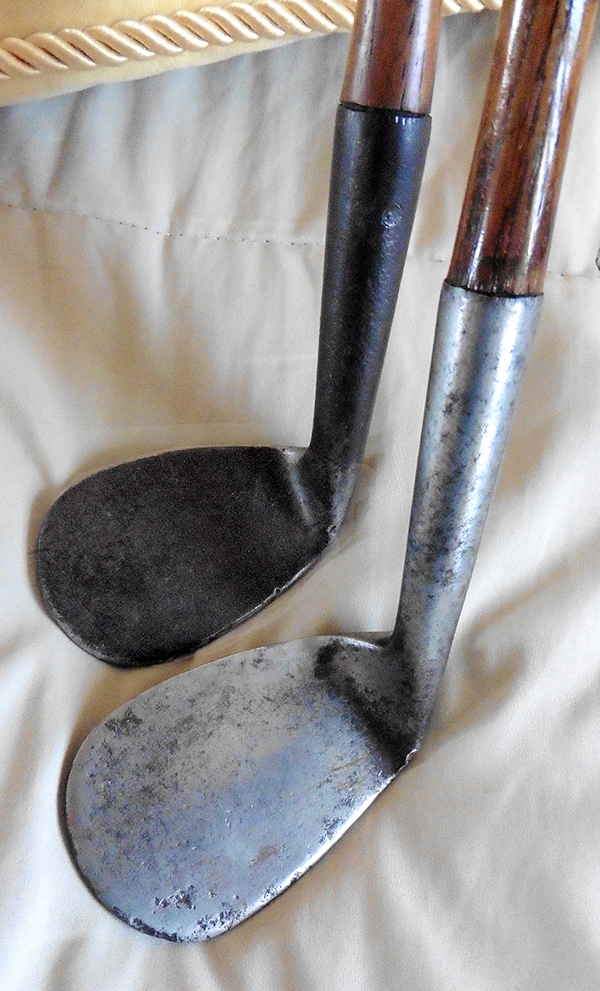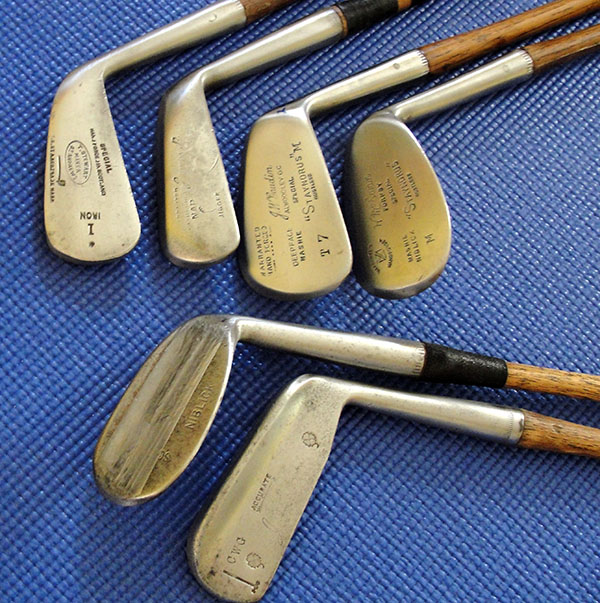This article focuses on the category of wood-shafted, or hickory golf clubs. Millions of clubs with wood shafts were made before 1935. In today’s rapidly growing sports collectibles market, no wood-shafted club is worthless, but only a small percentage of old clubs do have significant value. The category of steel-shafted, or “classic clubs” is covered elsewhere. The information presented here is very general, but will serve as a primer to facilitate your larger search.
How can you tell the best from rest? These tips will help:
- Any club that looks really unusual probably is, in collecting terms.
- Irons clubs with smooth faces (no lines, dots, or other patterns) went out of style before 1910. These are older and generally more valuable.
- Old wooden clubs with long, narrow heads are good.
- Clubs marked “patent” attract collectors, because they are rarer than non-patent clubs.
- Putters usually command more value than irons or woods, possibly because of the special bond golfers have with their putters. Also, putters have been experimented with more than any other type of club and many unusual examples can be found.
- Clubs marked “made in Scotland” are perceived by U.S. collectors are perceived as more desirable than domestic products.

These days, the majority of newly found clubs turning up for sale date from the 1920s and early 1930s, a great boom period when many people were attracted to the game and bought clubs. Most clubs from this era hold little for collectors because so many were manufactured. Patent clubs and the very unusual clubs are the exception to the rule. The golden era for club design was the 1890s. Few American clubs were made in this decade, but many were made in Scotland by the industry’s historic clubmakers.
Other sources to consider when seeking information on old golf clubs include:
• Your inner circle: Have a friend who’s a collector or knows one?
• Local golf businesses: Visit your neighborhood club-repair shop or local golf professional. Chances are pretty good they will know someone involved in collecting.
• The Golf Heritage Society (567-303-5584, or www.golfheritage.org). Administrators here can refer you to a knowledgeable collector in your area or state and provide the dates of local collectors’ meetings in your region.
• Memorabilia dealers: There are a number of full-time dealers in golf artifacts. Auction houses are also doing more with golf antiquities. Many are listed under Resources on this website. They are often in the market to buy better clubs as well as entire collections, or may handle consignment sales.
• The Society of Hickory Golfers – check this website for information on buying clubs and look under the Resources page for Regional Playing Groups. You may find one of these near you. Most such groups have several experts in club restoration techniques as well as those who could provide guidance in building a set of clubs for play or display.

EBay is filled with antique wood-shafted golf clubs for sale. But, it takes some expertise to successfully negotiate online auction or sales. Here you will find hundreds of both very rare and collectible clubs, and perhaps three times as many common clubs. Members of the Society of Hickory Golfers in particular look for specific playable clubs to fill out their play sets, often specializing by club maker or club type. Before you purchase anything online, know exactly what you are looking for. Check the SoHG website for helpful advice on buying hickory golf clubs.
Resources
• Wood Shafted Golf Club Value Guide, by Pete Georgiady, Airlie Hall Press
• Collecting Antique Golf Clubs, by Pete Georgiady, Airlie Hall Press
